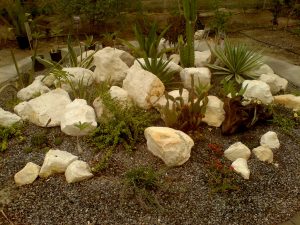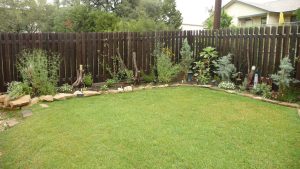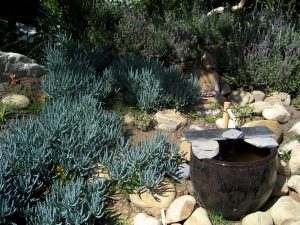Transforming your outdoor space into a lush oasis doesn’t have to be a water-intensive dream. I’m here to show you that with the right backyard drought-resistant garden ideas, you can cultivate a stunning landscape that’s both eco-friendly and low-maintenance. From the art of xeriscaping to choosing the perfect drought-tolerant plants, I’ll guide you through creating a garden that flourishes even in dry conditions.
Imagine your backyard as a haven of resilience, where every plant is perfectly adapted to thrive with minimal water. I’ll introduce you to innovative techniques and smart gardening practices that will help you conserve water while enjoying a vibrant and beautiful garden all year round. Stay tuned as we dive into the world of drought-resistant gardening, where beauty and sustainability go hand in hand.
Xeriscaping: A Water-Saving Technique for Your Backyard Garden

As our climate continues to change, drought-tolerant landscape designs are not just a trend but a necessity. I’ve embraced this challenge by venturing into the world of xeriscaping, a method of gardening that reduces the need for supplemental water from irrigation.
Water-Wise Garden Design
In creating a water-wise garden, the choice of plants is crucial. Drought-resistant landscaping isn’t sparse; it’s a lush symphony of plants strategized to thrive with minimal water. My palette includes a variety of drought-tolerant plants that are native to my region. These locals are naturally equipped to handle the climate’s demands, requiring far less attention from me. Incorporating ornamental grasses and native plants into my design isn’t just a visual statement – it’s a commitment to environmental stewardship.
Drought-Tolerant Landscaping Ideas for Your Space
For my backyard drought-resistant garden ideas, I often group plants with similar water, sun, and soil requirements together, a technique that optimizes watering efficiency and conserves water. I’ve replaced the traditional lawn with a tapestry of low-growing foliage and flowering plants, reducing my water usage and maintenance significantly.
The key to my drought-tolerant landscaping is the concept of zonation. Essentially, I organize the plants based on their water needs. Those that crave moisture indulge near the water sources, while the drought warriors guard the farther edges of my garden.
For ground cover, I tend to select plants with fleshy leaves or thick foliage that helps reduce water loss. An example is lamb’s ear, which has silver, velvet-textured leaves. Through careful selection and placement, these plants not only beautify my space but fortify the garden’s resistance to drought.
Xeriscaping Backyard Ideas That Save Water and Look Great
When I first thought of drought resistant landscaping, I imagined a stark, rocky terrain. But the reality couldn’t be more different. With enlarged patios or decks, strategic plantings of drought-resistant flora, and the incorporation of garden art, my backyard is as inviting as a traditional, water-guzzling garden.
Choosing the Best Drought-Tolerant Plants for Your Landscape

When designing a water-wise garden, choosing the right plants is crucial. I’ve learned that drought-tolerant plants not only save on water bills but also withstand the harsh conditions of a dry garden with minimal care. Let’s look into how we can populate our gardens with these resilient species.
Drought Tolerant Versus Drought Resistant
What’s the difference between drought-tolerant and drought-resistant plants? Well, drought-tolerant ones can handle dry conditions by storing moisture in their leaves or roots, while drought-resistant varieties actually thrive in water-scarce environments. In my garden, I aim to mix both types for a landscape that’s both beautiful and drought-proof.
Tap into Native Plants
Native plants are always my first choice. These locals are already adapted to our particular region and climate change. They’ve survived extended periods of little rain and have evolved to manage water loss efficiently. By grouping native plants together, I also create a focal point in my garden without needing much supplemental water.
Ornamental Grasses: A Wise Choice
Among my favorites are ornamental grasses, which add texture and movement to the landscape design. These grasses require very little water and deliver high impact. Plus, they offer a lush alternative to a traditional lawn that demands frequent watering.
Soil Matters
Amending the soil is another key consideration. Organic matter improves soil moisture retention and prevents soil erosion. My choice of organic mulch further helps to retain moisture, cutting down the water evaporation rate significantly.
Water-Wise Plantings and Grouping Techniques
To maximize efficiency, I practice water-wise plantings. This involves selecting low maintenance plants that require minimal water. By grouping plants with similar water requirements close together, I ensure that they help shade each other, reducing the garden’s overall water usage.
Creating a Foundation with Drought-Resistant Soil and Mulch

When dreaming up backyard drought-resistant garden ideas, it’s crucial to start with the backbone of any successful drought-tolerant landscape—the soil and mulch. Amending your soil is step one in creating an environment where drought-resistant plants can thrive.
Soil Amendment for Improved Moisture Retention
The first goal in crafting a drought-tolerant garden is to boost your soil’s ability to retain moisture. Amended soil blends organic matter like straw, horse manure, peat moss, or compost into the native earth, enhancing its texture and water-holding capacity. Even adding fallen leaves and allowing them to compost directly in the soil can make a significant difference. This practice helps reduce water loss and supports the health of drought-tolerant landscapes.
I’ve found that by simply covering the ground with a thick layer of organic mulch, I can minimize water evaporation and help maintain soil moisture levels. Remember that mulch not only retains moisture but also protects against soil erosion and adds vital nutrients as it breaks down.
Choosing the Right Mulch for Your Drought-Tolerant Landscaping
Not all mulch types are suitable for preserving a water-wise garden design. While organic mulch can be advantageous, it might hold too much moisture for drought-tolerant plants like cacti or succulents. For these varieties, opting for stones or pebbles can be a smart choice. These non-organic mulches fit seamlessly into drought tolerant landscape themes, such as a rock garden, allowing for minimal water usage without risking overhydration.
Preparing for a Drought-Resistant Ecosystem
In planning my drought-tolerant landscaping ideas, I’ve always valued the idea of incorporating a variety of textures and hues. Plants with gray or silver foliage, such as lavender, lamb’s ear, and dusty miller, are not only visually appealing but are champions of drought tolerance.
Furthermore, utilizing a smart drip irrigation system allows me to direct water straight to the roots, slashing wastefulness. By combining the elements of amended soil, appropriate mulch, and strategic watering systems, I’ve set up a strong foundation, preparing my garden to resist dry conditions with style.
Efficient Irrigation Systems for a Water-Wise Garden
In the realm of drought-tolerant landscaping, a smart irrigation strategy is a cornerstone. The goal is to minimize water waste while ensuring that precious resources are funneled precisely where needed. Traditional watering practices are often wasteful, especially with overhead sprinklers that contribute substantially to water evaporation.
Incorporating Drip Irrigation for Direct Watering
To combat this, I’ve found that drip irrigation systems are remarkably effective. They deliver water directly to the roots of the plants, dramatically reducing water loss and enhancing soil moisture conservation. The installation can be a DIY project or handled by professionals, but either way, the payoff in water conservation and plant health is undeniable.
Backyard Drought-Resistant Garden Ideas
In my water-wise garden, I ensure drought-resistant plants receive the hydration they need without excess. Even a small backyard garden can yield impressive results with the right landscape design. Utilizing drought-tolerant varieties like succulents or hardy ornamental grasses means my garden remains lush and vibrant, even with minimal water input.
The Importance of Grouping Plants
When planning, I always consider how best to group plants with similar water requirements. This technique not only creates a stunning visual effect but also ensures I’m not over or under-watering any area. The result is a cohesive, drought-tolerant landscape that thrives in its environment.
Mulching: A Critical Element in Drought Tolerant Landscaping
An often-overlooked aspect of drought-resistant gardening is mulching. By applying a generous layer of organic mulch, I help the soil retain moisture, regulate temperature, and suppress weed growth. Plus, it adds a polished look to my garden beds while further reducing the need for supplemental water.
Soil Preparation and Maintenance
To prepare my garden beds, I focus on amending the soil with rich organic matter. This ups the ante on moisture retention and makes sure every drop of water is used efficiently. I prioritize the amendment process because it sets the foundation for a successful drought-tolerant garden.
Designing a Stylish and Functional Outdoor Space with Drought-Resistant Elements

When approaching water-wise garden design, drought tolerance isn’t just a feature; it’s a necessity for sustainability and aesthetic value. I’ve learned that xeriscaping backyard ideas need not compromise beauty for resilience. Instead, blending drought-tolerant landscapes with functional design creates an outdoor oasis, perfect for relaxation and entertainment.
Backyard Drought-Resistant Garden Ideas
A key component in any drought-tolerant landscaping plan is the use of drought-resistant plants. These plants often have specialized adaptations such as fleshy leaves or deep root systems that help minimize water loss and maintain soil moisture even under dry conditions. By carefully selecting varieties that thrive in full sun with minimal water requirements, I can construct an environment that not only conserves water but also reduces soil erosion.
In my water-wise plantings, I group plants with similar water needs, which enables me to direct water more efficiently through a drip irrigation system. This strategic placement ensures each plant receives the exact amount of supplemental water needed without excess waste. Ornamental grasses become an integral part of the solution, adding texture and movement while requiring far less hydration than a traditional lawn.
One innovative idea I love to incorporate is a rock garden. It’s an attractive feature that also serves as a functional element to retain moisture and conserve water. The rocks can become a focal point while reflecting heat away from the plants, helping the surrounding soil stay cool and reducing water evaporation.
Embracing Organic Elements
Amending soil with organic matter is a game-changer in establishing a drought-tolerant garden. The right mix can significantly improve soil moisture retention and create a nurturing bed for those low maintenance plants that form the foundation of drought-tolerant landscape design. Incorporating organic mulch not only suppresses weeds but also serves as another layer to help reduce water loss, making it a dual-purpose component in drought-tolerant landscaping ideas.
Key Takeaways
Creating a drought-resistant garden isn’t just a savvy choice for conserving water; it’s a stylish and sustainable way to enjoy your outdoor space. By embracing xeriscaping principles and selecting the right plants and materials, you’re setting the stage for a stunning, low-maintenance haven that thrives in dry conditions. Remember, a well-planned drought-tolerant garden can be both a personal oasis and a testament to eco-friendly living. So go ahead, let your creativity flow and watch as your water-wise paradise flourishes.
Other suggested articles:


